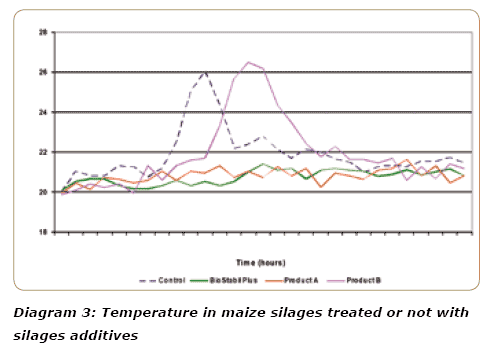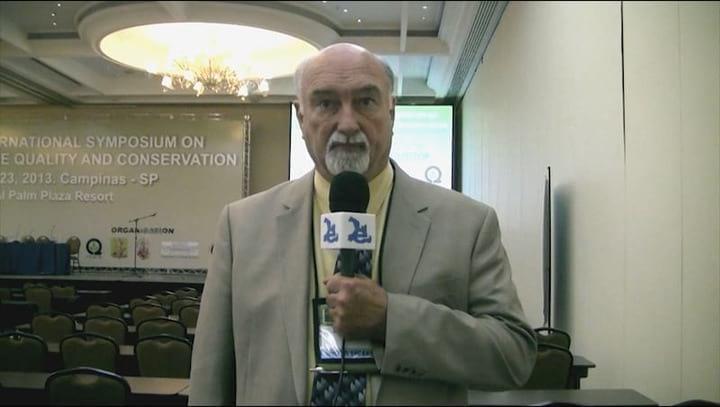Biomin® BioStabil: a silage additive product line which fits the needs of the producers
Published: March 17, 2008
By: Yunior Acosta Aragón, Technical Manager (Biomin GmbH)
Silage inoculants prevent the growth of undesirable microorganisms and therefore the nutrient losses caused by them, and ensure silage feed quality. In consequence, animal performance will be at a top standard level, even in periods of the year in which the availability of feedstuffs is insufficient.
Silage inoculants can be classified according to their effect on the matter to be ensiled or their mode of action. The main effects of the inoculants are:
Silage inoculants can be classified according to their effect on the matter to be ensiled or their mode of action. The main effects of the inoculants are:
a) to prevent undesirable fermentations and
b) to prevent silage spoilage during the feed out phase.
For these proposals producers can utilize three different products or a combination:
a) acids,
b) their salts and respectively their solutions and
c) biological silage inoculants.
b) to prevent silage spoilage during the feed out phase.
For these proposals producers can utilize three different products or a combination:
a) acids,
b) their salts and respectively their solutions and
c) biological silage inoculants.
Other silage additives with more limited use than the three cited above are molasses and enzymes. Salts and acids are used to cause an abrupt decrease in the pH value when the dry matter content of the raw material is out of the optimal range. In cases of low dry matter content, these products inhibit above all, the growth of Clostridia. High dry matter content very often means bad conditions for the compaction of the raw material; air stays inside the ensiled matter, and therefore anaerobic requirements for good silage are not reached. The advantage in the use of salts is that they are non-corrosive and easier and safer in application compared with their corresponding acids.
The design of adequate biological silage additives
Biological silage inoculants have been used and are established on the market because:
a) their proved effectiveness for accelerating fermentation and improving aerobic stability,
b) higher recovery in dry matter and energy content compared with non treated silages,
c) safety during usage and
d) relatively lower cost per treated ton compared with acids.
The quality of good biological silage inoculants must be decided, first, on the basis of the included strains and their proportions in the product. Multi-strain inoculants have the advantages of having the possibility to use different sources of energy and each strain can have a different desirable effect (rapid pH decrease, higher production of lactic acid, or acetic acid production for a better aerobic stability). Therefore it is possible to change the mode of action of a product containing the same strains but with proportions of the bacterial strains. On the other hand, different strains of the same microorganism will grow faster on different substrates, temperature conditions or moisture content (osmotolerance).
Another aspect to take into account is the number of bacteria in the product and per gram of silage. A review of the products existing on the silage additive market shows a variation from 100 000 to 1 000 000 cfu (colony forming units)/ g silage. Nevertheless some products have less than 100 000 cfu/ g silage, as shown in the following Diagram (1). Samples of silage additives available on the market were sent to the laboratory and analyzed for the total microbial count.

Most published authors agree that bacterial silage inoculants should guarantee at least 100 000 cfu/ g silage (Buckmaster, 2008; Kung, 2006). The amount of cfu itself is not a guaranty of the bacterial activity (for example, their osmotolerance) but in most cases it is an important factor to ensure a quicker and deeper fermentation.
The design of an adequate biological silage additive is a long process in which the strain(s) will be selected permanently, not only under laboratory conditions but also in field conditions. Their effectiveness is based on the activity of living microorganisms, therefore conditions for their growth must be created (Dry matter content, quick silo filling, good sealing, etc.).
The effectiveness of a biological silage additive can be measured using different methods. Under practice conditions it is very difficult to measure the success in terms of higher performance (milk and/ or meat production) because the whole process is conditioned by many factors. The first aspect to be taken into account is the silage quality, worded in simple parameters as pH value, fermentation acids and energy content, compared with the normal values for the ensiled crop or against a negative (no additive) or a positive (with other additive) control (see Diagram 2).

The selection of the right biological silage additive will be made taking into account some rules, firstly, the crop to be ensiled. According to the DLG (German Association for Agriculture, 2002) there are three types of crops from the point of view of “ensilability”, which are classified according to their fermentability coefficient (FC):
FC = DM + 8 x sugar content / puffer capacity
in:
• bad ensilable (FC < 35)
• middle ensilable and (35 < FC < 45) and
• good ensilable (FC > 35).
For bad ensilable substrates, the recommended biological silage additive should contain (principally) homofermentative bacteria which produce mainly lactic acid, which dramatically reduce the pH value (high negative correlation coefficient of more than 0.80 between lactic acid content and pH values). For good ensilable substrates as in whole maize crop, for example, the aim should be to increase the aerobic stability, because this kind of substrate is very rich in nutrients and they spoil very quickly when they come into contact with air and therefore yeasts and moulds (Kung and Ranjit, 2001; Driehuis et al., 1999). In the last case (improvement of the aerobic stability) biological silage additives with a higher ratio of heterofermentative bacteria are preferred for a higher production of acetic or propionic acid and the corresponding inhibition of undesirable spoilage microorganisms (Filya et al., 2004; Dawson et al., 1998). Nevertheless the use of propionate-producing propionic bacteria appears to be less suitable for the improvement of silage aerobic stability, due to the fact that these bacteria are only able to proliferate and produce propionate if the silage pH remains relatively high (Weinberg and Muck, 1996). In Diagram 1 the temperatures of maize silages – and therefore their aerobic stability – treated or not with different products are represented.

The composition of the products was: product Biomin® BioStabil Plus, a blend of homo- and heterofermentative bacteria; product A, a chemical product + L. plantarum; and product B a chemical product. It shows an increase of the inner temperature over 2 °C after 48 and 53 hours for the control treatment and product B respectively. The treatment with Biomin ® BioStabil plus was stable after 168 hours (7 days), which is a sign of the positive effect of the heterofermentative bacteria (acetic acid) on the aerobic stability.
In recent years, the combination of two or more bacterial strains has become a way to enhance the efficacy and to have a wider spectrum of applicability, for example, new additives which combine homofermentative and heterofermentative bacteria for a better fermentation and aerobic stability (Weinberg et al., 1999).
Biomin® BioStabil: a product line for advanced silage producers who care about their profit The product line Biomin® BioStabil is designed to take into account the necessity of offering a “solution package” for the producer. The product line Biomin® BioStabil contains homoand heterofermentative bacteria for a better fermentation and aerobic stability. Good fermentation is a guarantee of good dry matter and energy recovery. These parameters can be easily translated in animal performance and finally, in money. More importantly than the cost of the product itself for the producers should be the Return On Investment (ROI), meaning the relationship between the benefits over the cost. An effect on the energy and dry matter recovery is confirmed through the results of many field trials (Diagram 2). An economic profit calculation is shown in Diagram 4.
Only the extra incomes from milk make a ROI rate of 2.44. If the savings in concentrates for producing the same milk amount are considered, the ROI could reach 5.32.

Diagram 4: Economic profit expected on the basis of a higher energy recovery (+ 0.28 MJ/ kg DM in 60 tonnes)
Conclusions
Silage inoculants can not replace good ensiling practices. Their use, however, can considerably improve the silage quality, enlarge the aerobic stability and minimize the losses. The inclusion of a silage additive as a routine procedure in farming can substantially elevate the profits of farmers. The most important aspect to take into account is not the price but the Return On Investment (ROI). The most expensive silage inoculants are those which do not have the desired effect on the silage!
Literature
Buckmaster, D. (2008 accessed): Bacterial Inoculants for silage. Available in: http://www.age.psu.edu/extension/Factsheets/i/I111.pdf
Dawson, T. E.; S. R. Rust and M. T. Yokoyama (1998): Improved fermentation and aerobic stability of ensiled, high moisture corn with the use of Propionibacterium acidipropionici. Journal of Dairy Science Vol. 81, No. 4: 1015-1021
DLG (2002): Futterkonservierung. Siliermittel, Dosiergeräte, Silofolien. 6. Auflage, 2002
Driehuis, F.; W. J. Oude Elferink and S. F. Spoelstra (1999): Anaerobic lactic acid degradation during ensilage of whole crop maize inoculated with Lactobacillus buchneri inhibits yeast growth and improves aerobic stability. Journal of Applied Microbiology (87): 583-594
Filya, I.; E. Sucu and A. Karabulut (2004): The effect of Propionibacterium acidipropionici, with or without Lactobacillus plantarum, on the fermentation and aerobic stability of wheat, sorghum and maize silages. Journal of Applied Microbiology. Volume 97, N 4 (9): 818-826
Kung, L. Jr. (2006): Consider silage inoculant choices carefully. Copyright 2006 by W.D. Hoard & Sons Company, Fort Atkinosn, WI. Available in: http://www.qualitysilage.com/PDF/HoardsInoculantArticle.pdf
Kung, Jr., L. and N. K. Ranjit (2001): The effect of Lactobacillus buchneri and other additives on the fermentation and aerobic stability of barley silage. Journal of Dairy Science (84): 1149-1155
Macaulay, A. (2003): Silage Production – Introduction. Available in: http://www1.agric.gov.ab.ca/$department/deptdocs.nsf/ all/for4912
UN News Centre (2006): World cereal prices surge to 10-year highs due to poor harvests, bio-fuel demand– UN. Available in: http://www.un.org/apps/news/story.asp?NewsID=20878&Cr=food&Cr1
Weinberg, Z. G.; G. Szakacs; G. Ashbell and Y. Hen (1999): The effect of Lactobacillus buchneri and L. plantarum, applied at ensiling, on the ensiling fermentation and aerobic stability of wheat and sorghum silages. Journal of Industrial Microbiology and Biotechnology. Volume 23, Number 3 / September 1999
Weinberg, Z. G. and R. E. Muck (1996): New trends and opportunities in the development and use of inoculants for silage. FEMS Microbiology Reviews 19 (1): 53-68
Related topics:
Authors:
DSM-Firmenich
Recommend
Comment
Share
DSM-Firmenich
31 de marzo de 2008
Dear Mr Mitrik,
Thanks for reading the article and your comments. Related to them:
- positive controls were tested using biological silage inoculants available on the market. We did not use the names intentionally because of ethical principles.
- right, the DLG evaluates the effectiveness of silage inoculants also in the milk and meat production. That is one of the evaluations but not the only (correct), and the first and basical step in the evaluation is (and will be in my opinion) the silage quality.
- + 0.28 MJ NEL/ kg DM. In the calculation are 10% energy losses included.
Best wishes,
Yunior
Recommend
Reply
SCHAUMANN SLOVENSKO
31 de marzo de 2008
1. Diagram 2 - the positive control is not declared clearly. If it was only one product and his composition is not known, the results are not convincing.
2. DLG system evaluates effectivnes of silage conservants to the milk and meet production and this system is correct basis for comparison of products.
3. Diagram 4: Cogency of calculation can be higher if +0,28MJ(ME or NEL?)/kg DM is result from DLG trials and rating.
Dr.Tomáš Mitrík, FeddLab s.r.o. Spišská Nová Ves
Recommend
Reply

Would you like to discuss another topic? Create a new post to engage with experts in the community.








